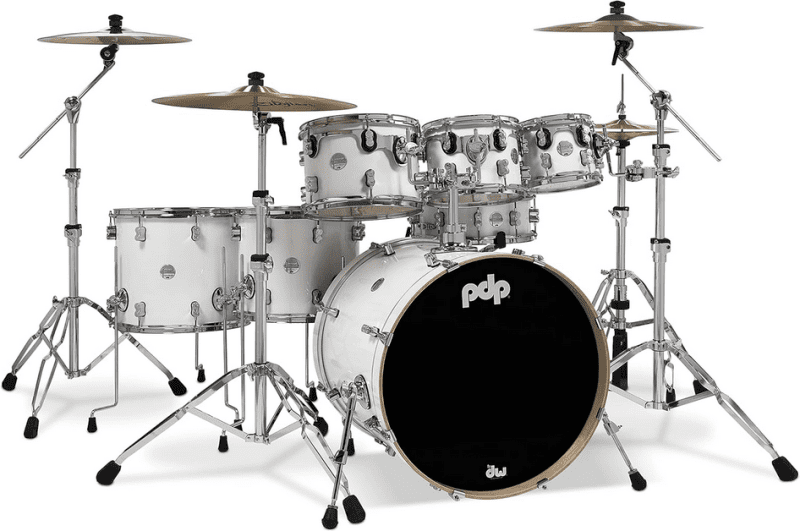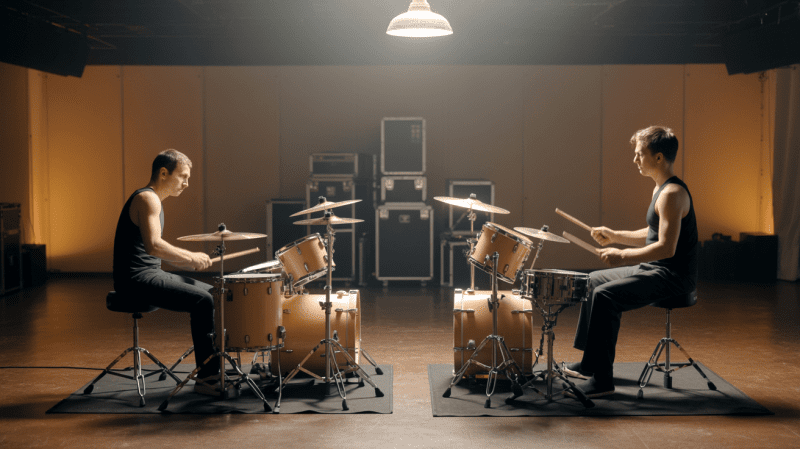
Drum notation is a universal language for drummers, allowing musicians to communicate rhythms, patterns, and techniques through written symbols rather than verbal instructions.
Understanding these symbols is essential for drummers, from beginners learning their first beats to professionals reading complex orchestral scores.
Unlike standard music notation representing pitches, drum notation uses specific symbols to indicate which drum or cymbal to play and how to play it.
This comprehensive guide will explain all the essential drum notation symbols, from basic note values to advanced performance techniques.
Key Takeaways
- Drum notation is a unique form of writing down music for percussion instruments.
- It's quick and easy to learn, serving as a language for drums.
- Understanding drum notation symbols is crucial for effective musical communication.
- This guide covers essential drum notation symbols and their meanings.
- Learning to read drum notation allows drummers to access published methods and transcriptions.
- A comprehensive drum notation symbols chart is included for reference.
Understanding the Basics of Drum Notation

The world of drumming relies heavily on a specialized form of notation that differs significantly from standard music notation. Drum notation is designed to convey the complex rhythms and techniques used in drumming.
What Is Drum Notation?
Drum notation is a system for representing drumming rhythms and techniques through written symbols. It allows drummers to read and play complex patterns with precision. The notation is specifically designed for percussion instruments, focusing on the various components of the drum set.
How Drum Notation Differs from Standard Music Notation
Unlike standard music notation, which focuses on pitch and melody, drum notation emphasizes rhythm and the specific drums or cymbals to be played. The notation system uses a unique set of symbols to represent different parts of the drum set, such as the bass drum, snare drum, and cymbals.
The Drum Staff and Clef
The drum staff consists of five lines and four spaces, similar to standard music notation, but it uses a specialized percussion or drum clef. Two vertical lines at the beginning of the staff represent the drum clef, indicating that the notation is for percussion instruments. Each line and space on the staff corresponds to a specific component of the drum set.
| Staff Position | Drum/Cymbal | Notation Symbol |
|---|---|---|
| Lower lines | Bass Drum | Solid note head |
| Middle lines | Snare Drum | Solid note head |
| Upper lines | Cymbals | X-shaped note head |
Understanding the layout of the drum staff and the meaning of its various positions is crucial for reading drum notation. Regardless of the rhythmic complexity, it tells the drummer which instrument to play and when.
The Drum Notation Symbols Chart
Drum notation is a unique system of symbols and markings that guide drummers through complex rhythms and techniques. Understanding these symbols is essential for interpreting drum sheet music accurately.
Basic Drum Set Notation
Basic drum set notation includes symbols for the various components of a standard drum kit. The notation for the bass drum, snare drum, and tom-toms is typically represented on the staff using different note heads and positions. For instance, the bass drum is often notated with a note head on the lower part of the staff, while the snare drum is notated on the middle line.
The notes on the staff correspond to specific drums or cymbals, allowing drummers to read and play the music as intended. This system enables drummers to identify which drum to play quickly and when, facilitating a smooth performance.
Cymbal Notation
Cymbal notation is equally important, as it dictates the type of cymbal stroke or technique used. Different cymbal sounds, like crashes, rides, or hi-hats, are notated using various symbols. For example, an "x" note head often represents a crash cymbal, while a "+" or "o" might indicate different hi-hat techniques.
Understanding these symbols is crucial for achieving the desired sound and expression in drumming. The correct interpretation of cymbal notation enhances a performance's overall musicality.
Special Percussion Notation
Special percussion notation extends beyond the standard drum kit, including auxiliary percussion instruments like cowbells, woodblocks, and electronic pads. These instruments are typically notated with distinctive note head shapes, such as triangles, diamonds, or squares, to differentiate them from standard drum components.
For instance, electronic drum pads are often indicated with square note heads, reflecting the growing trend of hybrid acoustic-electronic drum setups in modern music. When reading music with special percussion notation, drummers should check the notation key or legend explaining which symbols correspond to which instruments.
Reading Time Signatures and Measures
To master drum notation, it's essential to comprehend time signatures and measures, which provide the framework for rhythmic organization. Drum notation is written on the staff, separating notes by vertical bar lines. The space between these bar lines is called a "measure."
Common Time Signatures in Drumming
Time signatures indicate a piece's rhythmic structure by specifying the number of beats in a measure. Common time signatures in drumming include 4/4, 3/4, and 6/8. Understanding these time signatures is crucial for drummers to maintain the correct rhythm and synchronization with other musicians.
- 4/4 time is commonly used in many genres, including rock and pop, where there are four beats in a bar.
- 3/4 time, often used in waltzes, has three beats in a bar, creating a different rhythmic feel.
- 6/8 time, with six beats in a bar, is frequently used in complex or intricate musical pieces.
Understanding Measures and Bar Lines
Measures (bars) are the fundamental organizational units in drum notation, separated by vertical bar lines on the staff. Each measure contains a specific number of beats as defined by the time signature, creating a consistent framework for rhythmic organization.
- Bar lines serve as visual dividers, helping drummers track their place in the music and understand its rhythmic structure.
- Double bar lines indicate the end of a section or piece, while repeat signs (bar lines with dots) indicate that a section should be played again.
- Understanding how to count measures is essential for drummers, especially when following directions like "repeat measures 5-8" or communicating with other musicians.
Note Values and Counting in Drum Notation
Understanding note values and counting is crucial for drummers to interpret drum notation accurately. Drum notation is more than just symbols on a page; it's a language that, when understood, unlocks the ability to play complex rhythms and patterns.
Whole, Half, Quarter, and Eighth Notes
The most basic note values in drum notation are whole, half, quarter, and eighth notes. A whole note represents a full measure in common time, while a half note is half that duration. Quarter notes divide the beat into four equal parts, and eighth notes subdivide it. For example, in a 4/4 time signature, a whole note would be four beats, a half note two beats, a quarter note one beat, and an eighth note half a beat.
| Note Value | Duration in 4/4 Time |
|---|---|
| Whole Note | 4 beats |
| Half Note | 2 beats |
| Quarter Note | 1 beat |
| Eighth Note | 1/2 beat |
Sixteenth Notes and Beyond
Beyond eighth notes, we have sixteenth notes, which further divide the beat into even smaller parts. A sixteenth note is half the duration of an eighth note, making it a quarter of a beat in 4/4 time. This finer subdivision allows for more intricate rhythms and patterns, adding complexity to drumming.
Triplets and Other Tuplets
Triplets are a crucial element in drumming, allowing for a different rhythmic feel. A triplet divides a note or beat into three equal parts instead of the usual two, creating a distinctive swing or shuffle feel. For instance, eighth-note triplets divide a quarter note into three equal parts. Beyond triplets, other tuplets like quintuplets (five notes in the space of four) and septuplets (seven notes in the space of four or six) add further complexity and interest to drum patterns.
Mastering these various note values and tuplets is essential for drummers to enhance their rhythmic expression and versatility across different musical styles.
Drum Notation Symbols for Different Techniques
Drum notation encompasses a range of symbols that denote different playing techniques, each with its unique sound and application. Understanding these symbols is crucial for drummers to accurately interpret and perform musical compositions.
Sticking Patterns (R/L Notation)
Sticking patterns are notated using "R" for right-hand strokes and "L" for left-hand strokes. This notation helps drummers learn complex rhythms and coordination exercises. By following these patterns, drummers can develop their technique and improve their performance.
Accents and Ghost Notes
Accents are marked with symbols such as > or ^, indicating that a note should be played with more force or emphasis. On the other hand, ghost notes are played softly and often notated with parentheses around the note head. These notations add dynamic expression to drumming.
Flams, Drags, and Ruffs
Flams, drags, and ruffs are advanced techniques that add complexity and texture to drumming. A flam is notated with a grace note preceding the main note, while drags and ruffs involve multiple strokes leading into the main note. These techniques require precise coordination and control.
Rim Shots and Cross-Sticks
Rim shots and cross-sticks are specialized snare drum techniques. A rim shot is played by striking the drum head and rim simultaneously, producing a sharp, crisp sound, notated with a circle with a slash. Cross-sticks involve resting the stick tip on the drum head and striking the rim with the shaft, notated with an "x" on the snare drum line.
- Rim shots create a loud, sharp crack by striking the drum head and rim at the same time.
- Cross-sticks produce a high-pitched clicking sound by striking the rim with the shaft while the tip rests on the drumhead.
- These techniques are essential for various musical styles, including rock, funk, jazz, and ballads.
- Proper execution requires specific stick handling and balance techniques.
By mastering these techniques and understanding their notation, drummers can expand their expressive capabilities.
Cymbal Techniques and Their Notation
The art of cymbal playing involves mastering different techniques and notations to produce various sounds and effects. Cymbals are a crucial element in drumming, adding depth, texture, and emotion to musical performances.
Hi-Hat Techniques
Hi-hat techniques vary, including open, closed, and loose positions, producing distinct sounds. The drummer's foot operates the hi-hat, allowing for complex rhythms and dynamic control. For instance, the "hi-hat splash" is achieved by hitting the cymbals with the foot and then quickly releasing them apart to let them ring out, creating a "splash" sound. This technique is notated with specific symbols, often a circle with lines through it or the word "splash" above the note.
Crash, Ride, and Bell Techniques
Crash cymbals are used to add accents and dramatic flair to drumming. The technique involves hitting the crash cymbal with the shoulder of the stick on the edge, producing a sharp, explosive sound. Ride cymbals provide a steady rhythmic pattern, while bell techniques involve striking the cymbal's bell to produce a brighter, more focused sound. Each technique has its notation, allowing drummers to interpret the desired effect accurately.
Special Cymbal Effects
Special cymbal effects like chokes and splashes add dramatic accents and timbral variety to drum performances. A crash cymbal can be choked by grabbing it with the other hand after striking, cutting off the sound. This is notated with a note followed by a small "x" or the word "choke" above the staff. Splash cymbals, being smaller and quick-decaying, produce a bright, fast "splash" sound, notated above the crash cymbal line. These techniques are essential for creating dynamic moments in contemporary drumming.
Roll Notation and Techniques
Understanding roll notation and its associated techniques can significantly elevate a drummer's ability to perform precisely and expressively. Roll notation is a crucial drumming aspect involving various techniques to produce a sustained sound.
Open Rolls vs. Closed Rolls
A key distinction in roll notation is between open rolls and closed rolls. An open roll is played with clean double strokes, often called "diddles." In contrast, a closed roll, also known as a "buzz roll" or "orchestral roll," is played by buzzing the sticks rather than using distinct double strokes. A "Z" symbol on the note stem indicates when a buzz stroke should be used instead of diddles in sheet music.
| Roll Type | Technique | Notation |
|---|---|---|
| Open Roll | Clean double strokes (diddles) | No special notation |
| Closed Roll | Buzzing sticks | "Z" symbol on note stem |
Single-Stroke and Double-Stroke Rolls
Drummers also need to be familiar with single-stroke and double-stroke rolls. Single-stroke rolls involve a single stroke per hand in alternation, while double-stroke rolls involve two strokes per hand before alternating. These techniques are fundamental to various drumming styles and are notated differently based on the desired sound and effect.
Buzz Rolls and Crescendo Notation
Buzz rolls and crescendo notation are specialized techniques that add expressiveness to drum performances. A buzz roll involves pressing the stick into the drum head to create a sustained buzzing sound, notated with a "z" through the stem of a note. Crescendo notation indicates a gradual increase in volume throughout the roll, shown with a wedge-shaped symbol below the staff. The combination of buzz rolls with crescendos is particularly effective for building tension and creating dramatic moments in music.
"The combination of buzz rolls with crescendos is particularly effective for building tension and creating dramatic moments in musical performances." This highlights the expressive potential of mastering roll notation and techniques.
By mastering these roll techniques, drummers can enhance their performance and add depth to their music. Proper execution requires careful control over stick pressure and height, especially when performing crescendo rolls.
Dynamics and Expression in Drum Notation
Understanding dynamics in drum notation is essential for expressive performance. Dynamics refer to the varying degrees of loudness and softness in music, which are crucial for a drummer to convey emotion and add depth to their playing.
Dynamic Markings
Dynamic markings are notations that indicate the loudness or softness of the music. Common markings include pp (pianissimo, very soft), p (piano, soft), mp (mezzo-piano, moderately soft), mf (mezzo-forte, moderately loud), f (forte, loud), and ff (fortissimo, very loud). These markings guide the drummer in adjusting their playing to achieve the desired dynamic.
Crescendos, Diminuendos, and Accents
Crescendos, diminuendos, and accents are expressive elements that create dynamic shape and emphasis within musical phrases. A crescendo is a gradual increase in volume, notated with a right-facing "hairpin." Conversely, a diminuendo or decrescendo is a gradual decrease in volume, indicated by a left-facing "hairpin." Accents are emphasized notes marked with wedge-shaped symbols, indicating they should be played more forcefully.
- Crescendos and diminuendos require careful control of stick height and touch to achieve smooth volume changes.
- Accents add emphasis to specific notes, creating rhythmic interest and complexity.
- The interplay between these dynamic elements elevates drumming from mere timekeeping to musical artistry.
By mastering dynamics and expression in drum notation, drummers can significantly enhance their performance, bringing their music to life with nuanced expression.
Conclusion: Mastering Drum Notation in Practice
Mastering drum notation is a journey that requires dedication and consistent practice. To achieve success, it's essential to break down complex patterns into smaller, manageable parts and practice them daily. Start by learning the basic elements of drum notation, including staff layout, note values, and symbols.
Use a metronome to develop accurate timing and rhythmic precision as you progress. Apply your skills to diverse musical styles, from simple rock beats to complex jazz patterns. Record yourself playing from the notation and compare your performance to the written music to identify areas for improvement.
By following these tips and practicing regularly, you'll become proficient in reading drum notation and enhance your overall musicianship as a drummer. With time and patience, you can read drum notation easily and confidently, opening up new musical opportunities.
FAQ
Q: What is the difference between a quarter note and other note values in drum notation?
Q: How do I read the bass and snare drum parts in a piece of sheet music?
Q: What does the time signature indicate in drum notation?
Q: How do I notate cymbal parts, such as a crash cymbal, in drum notation?
Q: What is the purpose of a floor tom in a drum kit, and how is it notated?
Q: How do I interpret stickings (R/L notation) in drum notation?








